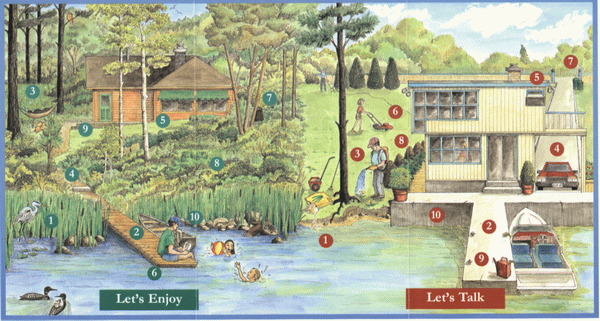HEALTHY SHORELINES
Healthy Shorelines
To learn more about healthy shorelines...
To find out what you can do...
|
Healthy Shorelines
Healthy shorelines are a great investment for clean water.
A well vegetated shoreline with shrubs and deep-rooted plants
filters chemicals and sediments which pollute our waters and
harm fish and wildlife. It keeps our shorelands intact by
absorbing energy from wave action and preventing erosion.
|
A healthy shoreline also provides essential habitat and travel
corridors for fish and wildlife, including species at risk.
It also provides a wonderful space for our relaxation and enjoyment!
Healthy natural shorelines are essential to industries including
fisheries, tourism and recreation, forestry and hydro.
If you�re a shoreline resident, the illustration below shows
how maintaining a healthy shoreline means less
work for you � not more!
|
 Graphic � Rideau Valley Conservation Authority 1998.
Graphic � Rideau Valley Conservation Authority 1998.
|
Let's Enjoy
|
- Natural shoreline - great wildlife habitat
- Small floating dock - low impact; hinged from a stationary platform or deck located above high water.
- Septic system far from the shore - reduces water pollution.
- Narrow, gravelled footpath - less chance of erosion.
- Trimmed trees and adjustable awnings - natural air conditioning with view maintained.
- You work less - relax more!
- Kitchen compost - improves soil quality.
- Low-maintenance native plants - provide shoreline buffer.
- Building - set back from shore and in character with setting.
- Well-maintained motor - electric or modern 4-stroke outboard, operated with low wake near shore.
|
Let's Talk
|
- Bare shoreline - subject to erosion; can be serious and affect your property value.
- Solid dock - destroys wildlife habitat, alters currents, causes erosion elsewhere.
- Fertilizer spills, chemical run-off and pet droppings - damage water quality.
- Paved lane - pollution-laden runoff, including oil and antifreeze leaks from your car, flows to water.
- No shade trees - overworked air conditioner adds to electric bill.
- Removal of natural vegetation - more work for you and more runoff.
- Collecting lawn clippings - deprives soil of nutrients; try mulching.
- Ornamental shrubs - require chemicals and extra work.
- Poor fuel management - gas and oil spills from cans, tanks and leaky boat motors are deadly.
- Hardened shoreline - eliminates natural filter, degrades water quality, blocks wildlife access.
|
To learn more about healthy shorelines...
|
top
|
|
What you can do...
|
top
|
We can all help to keep our shorelines healthy, whether we live by the
water, or just visit the shoreline every now and then. The best way to help
our shorelines is the easiest way too!
- Leave natural plants alone and let the shoreline grow wild!
- Leave natural debris such as stumps, fallen trees, or boulders
along the shoreline or in the water - these provide
food and wonderful homes for all types of animals.
- Leave the shoreline and beach area alone - don't dig holes or try to change the flow of a stream
- this can harm fish spawning habitat.
- Leave wildlife alone so that they are
not scared away from nests or food sources.
|
If you want to DO something, check out our
Shoreline Action Challenge
page for ideas on how you can help protect and restore shorelines!
|
|
 Graphic � Rideau Valley Conservation Authority 1998.
Graphic � Rideau Valley Conservation Authority 1998.